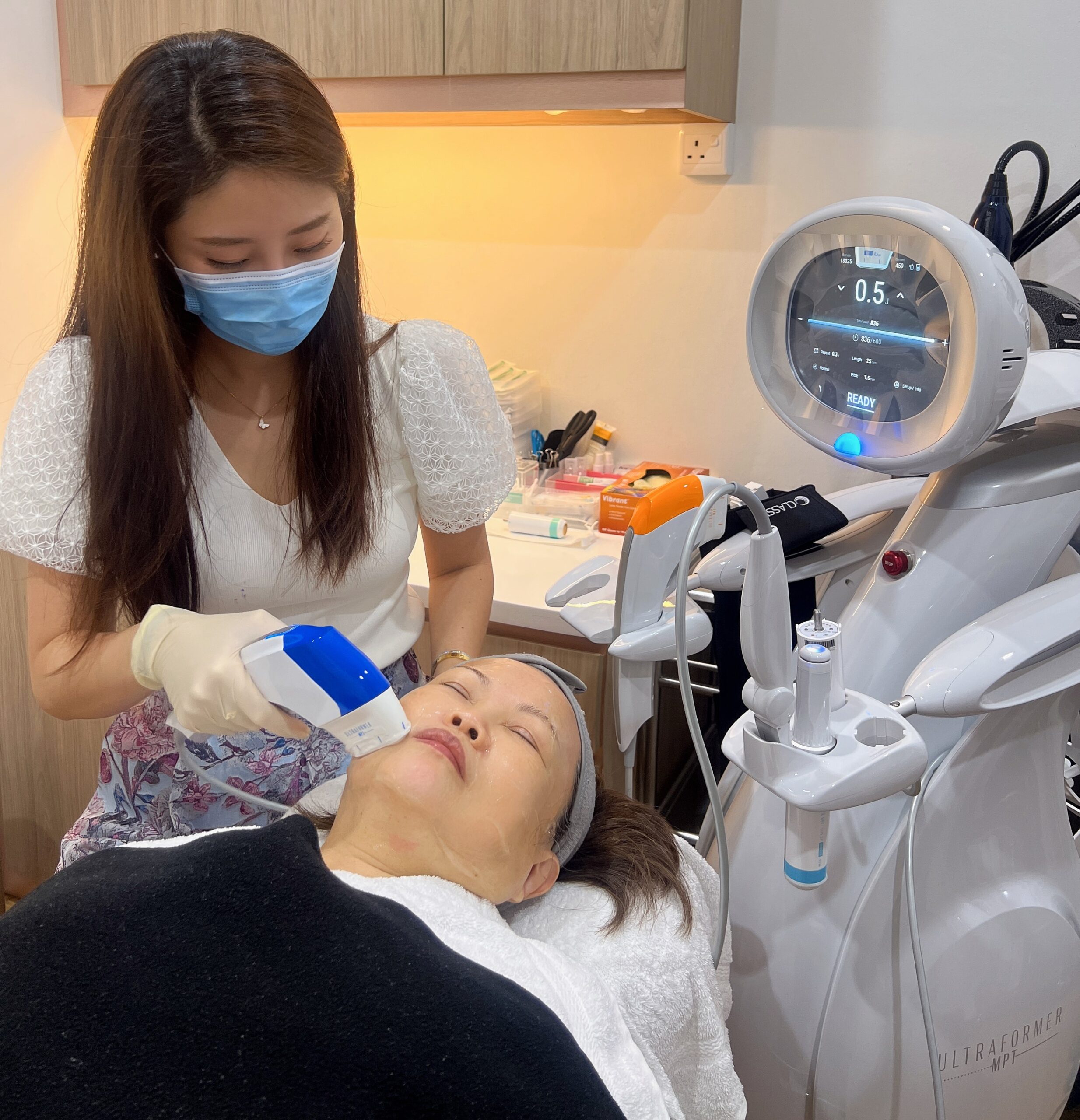High-Intensity Focused Ultrasound (HIFU) is a non-invasive cosmetic treatment designed to address skin tightening and lifting
HIFU works by delivering focused ultrasound energy to target deeper layers of the skin, stimulating collagen production. This process may help improve skin firmness and tightness without the need for surgery. Additionally, HIFU treatments are often preferred due to their minimal downtime, allowing most patients to resume normal activities shortly after the procedure.
In this article, we will explore the common side effects of HIFU and offer practical tips on how to manage them.
Common Side Effects of HIFU
While High-Intensity Focused Ultrasound (HIFU) procedure is generally considered safe, it is important to understand the potential side effects associated with this treatment. Being well-informed about what to expect can help you prepare and manage any post-treatment reactions effectively.
Here are some common side effects of HIFU:
Pain
During HIFU treatment, patients may experience mild discomfort, such as sensations of pinpricks or heat. This usually occurs during the procedure and subsides quickly. If necessary, an aesthetic professional can apply numbing cream or provide medication.
Redness
Mild redness is a common side effect immediately after HIFU treatment and typically subsides within a few hours.
Swelling
Some patients may experience mild swelling, which usually resolves within a few days.
Tingling and Numbness
A tingling sensation or temporary numbness may occur, particularly around delicate areas such as the eyes and lips. This is temporary and typically resolves within two weeks.
Blotchy Skin
Blotchy skin is possible, especially in individuals with sensitive skin, but it usually fades within a few hours.
Hyperpigmentation
In rare cases, hyperpigmentation may occur, causing areas of skin to darken. Although this side effect may take a long while to fade, it can often be managed with appropriate skincare.
In some instances, patients may not observe noticeable results immediately after HIFU treatment. This can be due to individual variations in skin response and collagen production.
Most side effects of High-Intensity Focused Ultrasound (HIFU) are mild and temporary, resolving within hours or days. More persistent effects, such as numbness or hyperpigmentation, are rare but should be discussed with a healthcare professional if they occur.
Here’s a quick comparison of Common Side Effects and Their Duration
| Side Effect | Description | Typical Duration |
|---|---|---|
| Pain | Sensation of pinpricks and heat during treatment | During treatment |
| Redness | Mild redness post-treatment | Few hours |
| Swelling | Mild swelling of the treated | Few days |
| Tingling | Tingling sensation, especially around delicate areas | Few hours to two weeks |
| Numbness | Temporary numbness in treated areas | Up to two weeks |
| Blotchy skin | Red and blotchy appearance, especially on sensitive skin | Few hours |
| Hyperpigmentation | Darkening of the skin; rare | Few days to several weeks |
How to Manage Common Side Effects
After understanding the common side effects of the HIFU procedure, it’s important to know how to manage them effectively to support a smooth recovery and achieve the best possible result.
Here are some practical tips:
Managing Redness
- Apply a cold compress to reduce inflammation and redness.
- Use aloe vera gel to soothe and cool the skin.
- Stay out of direct sunlight and use a broad-spectrum sunscreen with at least SPF 30.
Addressing Swelling
- Stay hydrated by drinking plenty of water to help reduce swelling.
Post-Treatment Skincare Routine
- Use a mild, non-abrasive cleanser to keep the skin clean without causing irritation.
- Apply a hydrating moisturiser to keep the skin nourished.
- Use a broad-spectrum sunscreen daily to protect the skin from UV damage.
- Steer clear of products containing retinoids, acids, or exfoliants for at least a week.
- Drink enough water to maintain skin hydration.
Rare and Serious Side Effects
While HIFU is generally safe, rare and more serious side effects can occur. These include:
Prolonged Pain
In rare instances, patients may experience discomfort or pain lasting several weeks. If this happens, consult your healthcare provider for pain management options.
Burns and Blisters
Improper application of High-Intensity Focused Ultrasound (HIFU) can lead to burns or blisters. To minimise this risk, ensure the procedure is performed by a qualified professional.
Nerve Damage
Although extremely rare, HIFU can cause nerve damage, resulting in temporary or permanent numbness or weakness in the treated area. If you experience unusual sensations, contact your doctor immediately.
Scarring
Although uncommon, scarring may occur if the skin does not heal properly after treatment. Following a proper skincare routine and adhering to post-treatment instructions can help prevent this.
To manage these effects:
- Seek medical advice promptly if you experience severe or prolonged side effects.
- Schedule follow-up appointments with your healthcare provider to monitor your recovery.
- Adhere strictly to the aftercare instructions provided by your practitioner to minimise risks.
When to Seek Medical Attention
While High-Intensity Focused Ultrasound (HIFU) treatments are generally safe, it is crucial to recognise when to seek professional medical attention. Although severe side effects are rare, they can occur, highlighting the importance of having the procedure performed under professional supervision.
Here’s what to look out for:
Signs That Require Professional Consultation
- Severe, intense, or prolonged pain lasting beyond a few days.
- Any signs of burns or blisters.
- Persistent numbness, tingling, or weakness.
- Redness, swelling, or discharge indicating infection.
- Unusual scarring or changes in skin texture.
Is HIFU treatment painful?
HIFU treatment can cause some discomfort, typically involving sensations of pinpricks and heat during the procedure. Pain levels vary depending on individual sensitivity and the area being treated. Most discomfort is temporary and subsides shortly after the procedure. Numbing cream or oral medication can be used to minimise discomfort.
Can I resume normal activities after HIFU treatment?
Yes, most patients can resume normal activities immediately following HIFU treatment. While mild side effects such as redness or swelling may occur, they usually do not interfere with daily activities. However, it is advisable to avoid strenuous exercise and direct sun exposure for a few days to allow the skin to heal properly.
Who is at risk for more severe side effects from HIFU?
Individuals at higher risk for more severe side effects include those with sensitive skin, underlying health conditions such as autoimmune disorders, or those who do not adhere to aftercare instructions. Sensitive skin may lead to prolonged redness or swelling, while certain health conditions can affect the healing process.
Ignoring aftercare instructions can increase the risk of complications. It is essential to consult a qualified practitioner who can assess your risk factors and tailor the treatment and aftercare to your needs for a safer experience.
Can HIFU cause permanent damage to the skin?
Permanent damage from HIFU is extremely rare, especially when performed by a skilled practitioner. Ensuring that the procedure is conducted by an experienced professional who follows proper techniques and safety protocols reduces the risk of serious side effects, such as burns, blisters, or nerve damage.
Following aftercare instructions and choosing a certified clinic can further minimise risks and help ensure the best possible outcome.
How often can I undergo HIFU treatments without increasing side effects?
The frequency of HIFU treatments varies based on individual needs and the treatment plan recommended by your practitioner. Generally, patients undergo HIFU once a year to maintain results without increasing side effects.
Some may benefit from follow-up sessions every 6 months, depending on the desired outcomes. It is important to consult a qualified practitioner to assess your skin’s response and determine the appropriate treatment frequency for safety and effectiveness.
Conclusion
Understanding the potential side effects of the HIFU procedure and how to manage them can contribute to a safer and more effective treatment experience. Common side effects such as redness and swelling can be managed with proper aftercare, while severe effects are rare when the treatment is performed by skilled practitioners.
If you are considering HIFU, consult a qualified professional and follow their guidance to ensure the best results and minimise risks. Proper care and adherence to aftercare protocols are key to achieving the best possible outcomes and maintaining healthy, rejuvenated skin.





